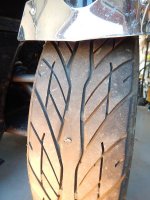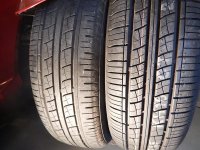Zummyannie
New member
Once you get to these wear bars the tire seems only half worn. Should the tire be replaced? Seems pre mature
Once you get to these wear bars the tire seems only half worn. Should the tire be replaced? Seems pre mature
Once you get to these wear bars the tire seems only half worn. Should the tire be replaced? Seems pre mature


Also, I've read that 90% of punctures happen during the last 10% of a tire's legal tread life.(sounds reasonable to me)I usually do not run tires that low. If you aren't comfortable with the tread you have left, change the tire. Peace of mind is important when riding.
Also, I've read that 90% of punctures happen during the last 10% of a tire's legal tread life.(sounds reasonable to me)
..... Twice I've gotten punctures in nearly brand new motorcycle tires. :banghead:
That can be due to running your tire pressures too high; or using too much throttle on take off in the loose stuff!!pps:
Pump your tires up too much & the tread cant 'flex or fold' at all if it hits an obstacle or debris on the road like it needs to in order to conform over stuff instead of impaling it straight thru the tread!! As for the spinning tire thing, those events are usually obvious & your choice!
Whatever the reason for it happening, getting punctures in a new tire are a right pain!!
I'm fastidious about my tire pressures on the bikes.....
If you are talking about GENUINE MTC ( two wheel type ) tires, well their contact patch is quite small compared to a Spyder .... Even tho a Gold Wing weighs about the same ..... So the amount of pressure to the ground is HUGH compared to the Spyder ....................jmho ...... Mike :thumbup:I must be in the 10%. Twice I've gotten punctures in nearly brand new motorcycle tires. :banghead:
Go to your local auto zone or other auto
parts store and buy a tread depth gauge,
most all tires except truck tires start out
with 11/32 to 13/32 tread depth when new
the wear bars are molded in the tire to be
visible at 2/32.
You must be the judge I personally would
replace any tire with the wear bars showing.
Tires and brakes are the cheapest insurance
you can buy.
Dave
I reread your post looking for a statement I could agree with and there wasn’t one. The idea that a manufacturer recommends pressures to sell more tires is odd, at best. Never go by the tire specs as they do not take into account the complicated interface of your particular suspension. (shocks, springs , swaybars and front to rear weight balance) There is much more to optimal psi than the load on a tire!! My wife’s car has a near 50/50 weight balance and the manufacturer calls for 33 psi front and 41 psi rear to properly work with her car. My car (approx. same overall weight) calls for 30 psi all around. Both are high perf cars whose manufacturers are looking for every bit of perf bragging rights they can achieve. The vehicle manufacturer takes all of that into account as they test the vehicle during the design process.Ahh, but WHAT pressures are you being fastidious about running??
The bike manufacturers 'sell a lot of bikes' recommendation for the stock tire, or the tire manufacturers recommendation for the load which that particular bike & you/the rider place upon the tires you have fitted to the bike??
You are absolutely right about the soft compound sport tire not helping, & maybe those particular punctures weren't contributed to by compromising tire pressures, but even the softest of compound tires will be way more likely to resist puncturing by a screw or construction staple IF it is being run at the correct pressure for that tire under the load currently being imposed upon it rather than it will if it's blown up to a pressure intended to help the bike manufacturer make lots of sales..... :sour:
Tires inflated too much will work just like a balloon that's been blown up close to its maximum - the balloon inflated to its maximum certainly looks good, bounces around well, but pretty much touch it with anything that's the slightest bit sharp & it punctures & bursts!! Heck, a balloon blown up hard enough can even be burst by gently landing on a soft green lawn!! Same balloon, blown up 'not quite so hard' might look slightly smaller, bounce around not quite so well (but it'll be very close) and yet it'll be waaayyyy more resistant to puncturing by anything!! The first, you can often burst just by poking it with a blunt finger (or letting it touch a soft blade of grass!) the second will just conform over a poking finger (or a spiky blade of grass) because it isn't pumped up so hard & therefore has a little more scope for flexing & wrapping over/around an obstacle that the first just doesn't have!!Then just for a giggle, try pressing the first balloon gently against a pane of glass & sliding it along the pane?? Generally, it'll be easy enough to do.... But do that with the second balloon, pressing it in with the same force & then trying to slide it along the glass.... almost always, you'll find it just ain't gonna happen cos the 2nd balloon conforms more to the pane of glass & has a whole lot more traction upon it!! I wonder, will that help when applied to bike tires?!?
Yep, it will! But you will need to know the use & load you are placing on the particular tires you are running and check that Tire Manufacturers recommended inflation specs for the use & load you are placing upon them, instead of just taking the bike manufacturers recommendation that's somehow meant to work for any tire as well as anyone/everyone in all circumstances & carrying any load placed upon it.... :shocked:
